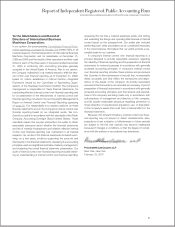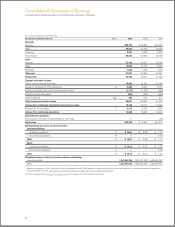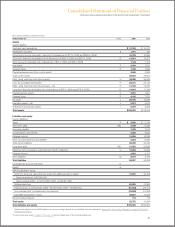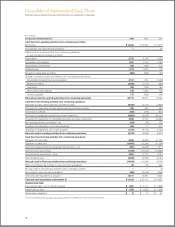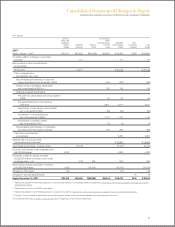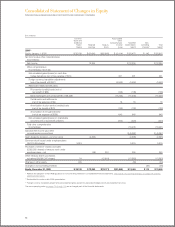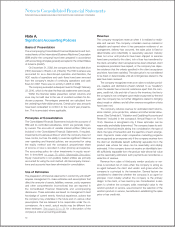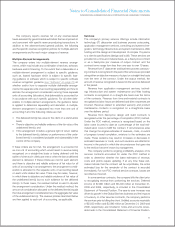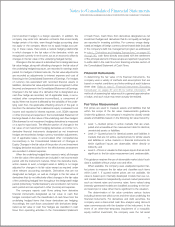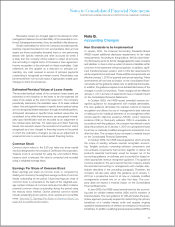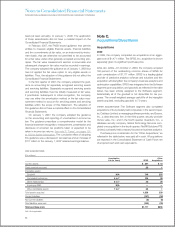IBM 2009 Annual Report Download - page 74
Download and view the complete annual report
Please find page 74 of the 2009 IBM annual report below. You can navigate through the pages in the report by either clicking on the pages listed below, or by using the keyword search tool below to find specific information within the annual report.
Notes to Consolidated Financial Statements
INTERNATIONAL BUSINESS MACHINES CORPORATION AND SUBSIDIARY COMPANIES
Billings usually occur in the month after the company performs
the services or in accordance with specific contractual provisions.
Unbilled receivables are expected to be billed within four months.
Hardware
Revenue from hardware sales and sales-type leases is recog-
nized when risk of loss has transferred to the client and there
are no unfulfilled company obligations that affect the client’s final
acceptance of the arrangement. Any cost of standard warranties
and remaining obligations that are inconsequential or perfunc-
tory are accrued when the corresponding revenue is recognized.
Revenue from rentals and operating leases is recognized on a
straight-line basis over the term of the rental or lease.
Software
Revenue from perpetual (one-time charge) license software is
recognized at the inception of the license term if all revenue
recognition criteria have been met. Revenue from term (recurring
license charge) license software is recognized on a subscrip-
tion basis over the period that the client is entitled to use the
license. Revenue from subscription and support, which includes
unspecified upgrades on a when-and-if-available basis and
technical support, is recognized on a straight-line basis over
the period such items are delivered. In multiple-element revenue
arrangements that include software that is more than incidental
to the products or services as a whole (software multiple-
element arrangements), software and software-related elements
are accounted for in accordance with guidance on software
revenue recognition. Software-related elements include software
products and services, as well as any non-software deliverable
for which a software deliverable is essential to its functionality.
A software multiple-element arrangement is separated into
more than one unit of accounting if all of the following criteria
are met:
• The functionality of the delivered element(s) is not dependent
on the undelivered element(s);
• There is vendor-specific objective evidence (VSOE) of fair
value of the undelivered element(s). VSOE of fair value is
based on the price charged when the deliverable is sold
separately by the company on a regular basis and not as
part of the multiple-element arrangement; and
• Delivery of the delivered element(s) represents the culmina-
tion of the earnings process for that element(s).
If any one of these criteria are not met, the arrangement is
accounted for as one unit of accounting which would result
in revenue being recognized on a straight-line basis or being
deferred until the earlier of when such criteria are met or when
the last undelivered element is delivered. If these criteria are met
for each element and there is VSOE of fair value for all units of
accounting in an arrangement, the arrangement consideration
is allocated to the separate units of accounting based on each
unit’s relative VSOE of fair value. There may be cases, however,
in which there is VSOE of fair value of the undelivered item(s) but
no such evidence for the delivered item(s). In these cases, the
residual method is used to allocate the arrangement consider-
ation. Under the residual method, the amount of consideration
allocated to the delivered item(s) equals the total arrangement
consideration less the aggregate VSOE of fair value of the unde-
livered elements.
Financing
Financing income attributable to sales-type leases, direct financ-
ing leases and loans is recognized on the accrual basis using the
effective interest method. Operating lease income is recognized
on a straight-line basis over the term of the lease.
Services Costs
Recurring operating costs for services contracts, including costs
related to bid and proposal activities, are recognized as incurred.
For fixed-price design and build contracts, the costs of external
hardware and software accounted for under the POC method
are deferred and recognized based on the labor costs incurred
to date, as a percentage of the total estimated labor costs to
fulfill the contract. Certain eligible, nonrecurring costs incurred in
the initial phases of outsourcing contracts are deferred and sub-
sequently amortized. These costs consist of transition and setup
costs related to the installation of systems and processes and
are amortized on a straight-line basis over the expected period
of benefit, not to exceed the term of the contract. Additionally,
fixed assets associated with outsourcing contracts are capital-
ized and depreciated on a straight-line basis over the expected
useful life of the asset. If an asset is contract specific, then the
depreciation period is the shorter of the useful life of the asset or
the contract term. Amounts paid to clients in excess of the fair
value of acquired assets used in outsourcing arrangements are
deferred and amortized on a straight-line basis as a reduction of
revenue over the expected period of benefit not to exceed the
term of the contract. The company performs periodic reviews
to assess the recoverability of deferred contract transition and
setup costs. This review is done by comparing the estimated
minimum remaining undiscounted cash flows of a contract to
the unamortized contract costs. If such minimum undiscounted
cash flows are not sufficient to recover the unamortized costs,
a loss is recognized.
Deferred services transition and setup costs were $2,432
million and $2,023 million at December 31, 2009 and December
31, 2008, respectively. The primary driver of the increase
was the continued growth of the Global Services business.
Amortization expense of deferred services transition and setup
costs is estimated at December 31, 2009 to be $689 million in
2010, $562 million in 2011, $464 million in 2012, $430 million in
2013 and $287 million thereafter.
Deferred amounts paid to clients in excess of the fair value
of acquired assets used in outsourcing arrangements were $72
million and $119 million at December 31, 2009 and December
31, 2008, respectively. Amortization of deferred amounts paid to
72



